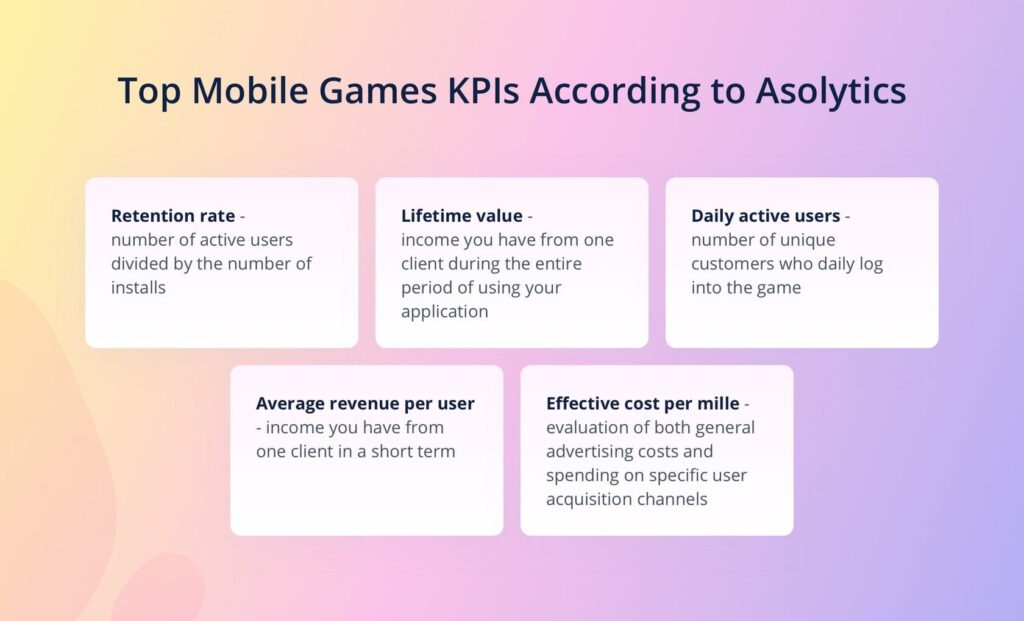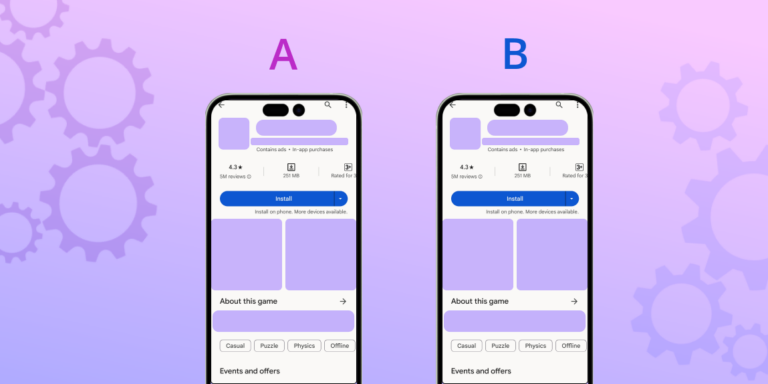Analytics is an essential part of any workflow, including mobile game development. How to understand the effectiveness of your actions and evaluate the results? How to optimize production? How to plan further expansion and motivate employees? The answer to all questions is mobile gaming metrics.
KPI stands for Key Performance Indicators, and by and large, the name speaks for itself. They represent certain parameters and specific values that you already have and that you want to achieve. The complete set of such indicators can differ depending on the industry, your goals, and even a specific product. Inexperienced business owners might believe that KPIs are just a tool to motivate employees when it comes to evaluating the effectiveness of each individual’s actions. Yes, they do that part of the job. However, their capabilities are much wider, and the importance of choosing the right parameters for the entire production can hardly be overestimated.
In this article, we will explain in detail why KPIs are important for your business. We will also talk about the main metrics used in the gaming industry so that you can evaluate your work after reading the post.
Table of Contents
Importance of KPIs
To generalize this concept a bit, we can say that KPIs are universal tools for assessing the effectiveness of the forces and resources spent and the outcome obtained as a result of these actions. They can be individual, depending on the approach for each company and business segment. Despite it, the introduction of the system of mobile game KPIs provides clear advantages for any company:
- It is an opportunity to evaluate the work done by one employee, a particular department, and even the whole company.
- With the help of metrics, you can identify weak points and streamline internal business processes.
- Such parameters allow you to determine the growth points and plan the company’s development. It is unwise to add new levels to the game if the effort spent on development does not pay off.
- Thanks to KPIs, all your actions have a basis. That is, you can decide to expand a business or, conversely, close it not intuitively but with clear arguments in hand.
- The rating system motivates employees to achieve the best result.
Among the many existing key performance indicators for developers, the most obvious index of success is money. If the profit grows, it means the project is in demand among users. However, with a competent approach, you should understand exactly how success was achieved, what needs to be done to maintain it, how to prevent resource depletion, and so on. For all this, you should use the KPIs system if you want to build one of the top mobile games.
Top 5 Mobile Game KPIs to Track
As we have already said, there is no single list of metrics to be used. Each business should determine for itself which KPIs will most fully reflect the state of its project.
When choosing a set of parameters, you should start from the features of your audience, the monetization model selected, stack complexity, stage of growth, the usefulness of specific indicators for your business, and so on. Below is a list of KPIs that work well together and are most commonly used in mobile game development.
- Retention rate
High retention rates are what all developers strive for. If customers continue using your game after a few days, weeks, or months, you have offered them an interesting project. The mobile games retention rate formula means dividing the number of active users by the number of installs.
Calculations should be made on the first day of installation of your product, and then on the third, fifth, and seventh day, and also after 30 days. This long-term metric gives you the ability to measure audience engagement, as well as understand at which point in the product’s life people begin to lose interest in it. - Lifetime value
This is one of the metrics that is used to evaluate the performance of your mobile game user acquisition strategy. LTV shows how much income you have from one client during the entire period of using your application. For example, if you spent $10 to attract a visitor and received only $6, this approach is considered unprofitable and requires a review of actions.
That is why some developers encourage their customers to bring friends. In this case, the amounts spent can be divided by two (as you do nothing to engage the other person), significantly reducing costs. - Daily active users
As the name implies, DAU shows you the number of unique customers who daily log into your game. The calculation for this metric might vary depending on which activities you use for your product as an estimate. It is used to understand how fun your game is and whether it makes customers come back to it again and again. A high and stable DAU is an indicator of a sustainable project. - Average revenue per user
The average revenue per user of mobile games is another indicator of the effectiveness of your monetization model. You can evaluate it every day, week, or month to see how your earnings progress. This indicator is in many ways similar to LTV; however, it does not show you data for the entire period of use but a short term.
This metric is also handy for assessing the performance of any changes to the product, including page assets in app stores. If page optimization isn’t producing the results you want, check out our pro tips like “Designing a Game App Icon.” - Effective cost per mille
To attract users, you can use various advertising tools, the effectiveness of which also needs to be properly evaluated. For it, there is an eCPM metric. Depending on what exactly you want to measure, you can use it to get different mobile game monetization statistics.
That is, you can evaluate both general advertising costs and spending on specific user acquisition channels. Variables might also depend on the region, the operating system of clients, and so on.

Key Performance Indicators
When selecting the optimal set of KPIs, it is vital that they are effective specifically for your case. While there is no one-size-fits-all package, Asolytics recommends that you choose metrics that allow you to cover the five main segments listed below. In addition to the indicators that we have already described in the previous paragraphs, you can also use extra ones:
- Mobile gaming growth rate: downloads, reinstalls, sign-ups, customer base growth rate, etc.;
- User experience quality: crashes, breakdowns, user action errors, replayability, progress, and so on;
- Customer engagement: MAU, churn rate, stickiness, session length, and their number per day;
- Monetization model: average transaction value, cost per install, and purchase time;
- Infrastructure: throughput, infrastructure cost, latency, uptime, and more.
The choice of specific metrics depends on the complexity of your project and the monetization model. Some are only applicable to free-to-play games; others are available for any kind. In addition to the indicators covering the segments described above, choosing those that will help you evaluate both short-term and long-term actions is essential as well.
When working on games, you need to try to avoid stagnation, which often happens to newcomers after a quick start and then a gradual decline. If it does happen, using suitable KPIs will help you identify weak points and work on them.
Pick Optimal Mobile Game KPIs for Your Business
In fact, the mobile game industry uses dozens of indicators that allow developers to evaluate various aspects of their work. The choice can really be overwhelming, especially for beginners. Determining which ones you need can be a daunting task. We recommend following these steps when choosing KPIs:
- Define your main goal. It should be real, specific, and doable. For example, you might need to lower the churn rate by half compared to the current rates.
- Determine intermediate stages. The global goal should be broken down into several small ones that will help you understand exactly how you can achieve the desired result. Understand at which stage customers leave you, what can make them return, how to get users to spend more time on your product, etc.
- Select appropriate KPIs that will help track the progress of the tasks and plans.
- Adjust your strategy as needed. Check if the metrics you choose provide the data you need, and remove or add those that give you a better understanding of the picture.
The KPIs are valuable tools for monitoring the effectiveness of your work on the game. Don’t be afraid to adjust it occasionally to get the best results.




